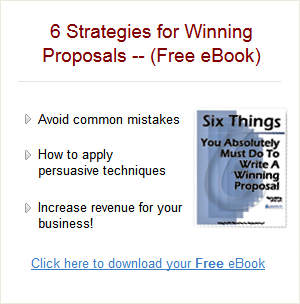Discover The Best Way to Sell Yourself in A Proposal
I realize you have heard this before. I know my clients have (I say it all the time, like a broken record). But I’ll say it again:
Your client buys what you’re selling because she perceives it as having some benefit to her!
That’s maybe obvious. But here’s something that isn’t so obvious:
You need to point out what the benefit is, even if you think it’s obvious.
Too often proposal writers think they’re calling out benefits, when what they’re really doing is simply citing the features of their offering.
Features vs. benefits. A feature is a characteristic of your approach; it’s a part of what you are offering the customer. A feature of a refrigerator, for example, is its cold drink dispenser in the door. Now, this may be a benefit to some buyers, but the benefit is not intrinsic; the cold drink dispenser by itself is not a benefit.
A benefit is what the feature does for the client. The cold drink dispenser lets the user have cold water with very little effort on her part. She likes that, and sees how it would simplify her life; the feature makes the refrigerator more attractive to her than one without that feature. That’s the benefit of the feature.
Too often proposal writers assume the intrinsic niftiness of their technical solution is self-evident, that just citing a feature will be enough for the reader to immediately see its benefit. Not likely. It’s your job to point out the obvious, because the obvious really isn’t.
How do you know what the client will consider a benefit? This is a direct result of your win strategy brainstorming. And the benefit statements you use are the manifestations of your proposal themes.
Characteristics of effective benefits statements. Benefits statements vary according to what your client thinks is important. But in general they
- Should be the major point of the section.
- Must be conclusive, factual, quantified, and brief.
- Must be stimulating; it needs to capture the readers’ attention and drive them to seek proof in the text and graphics of the section.
Benefits are the heart and soul of a proposal; they’re what will close the sale to the client. Citing clear and direct benefits to the client is also an excellent way to spike yourself above the competition. You want the client to feel she will get more value from your solution than from anyone else’s. In the end, the proposal that has the biggest benefit to the client will win.

